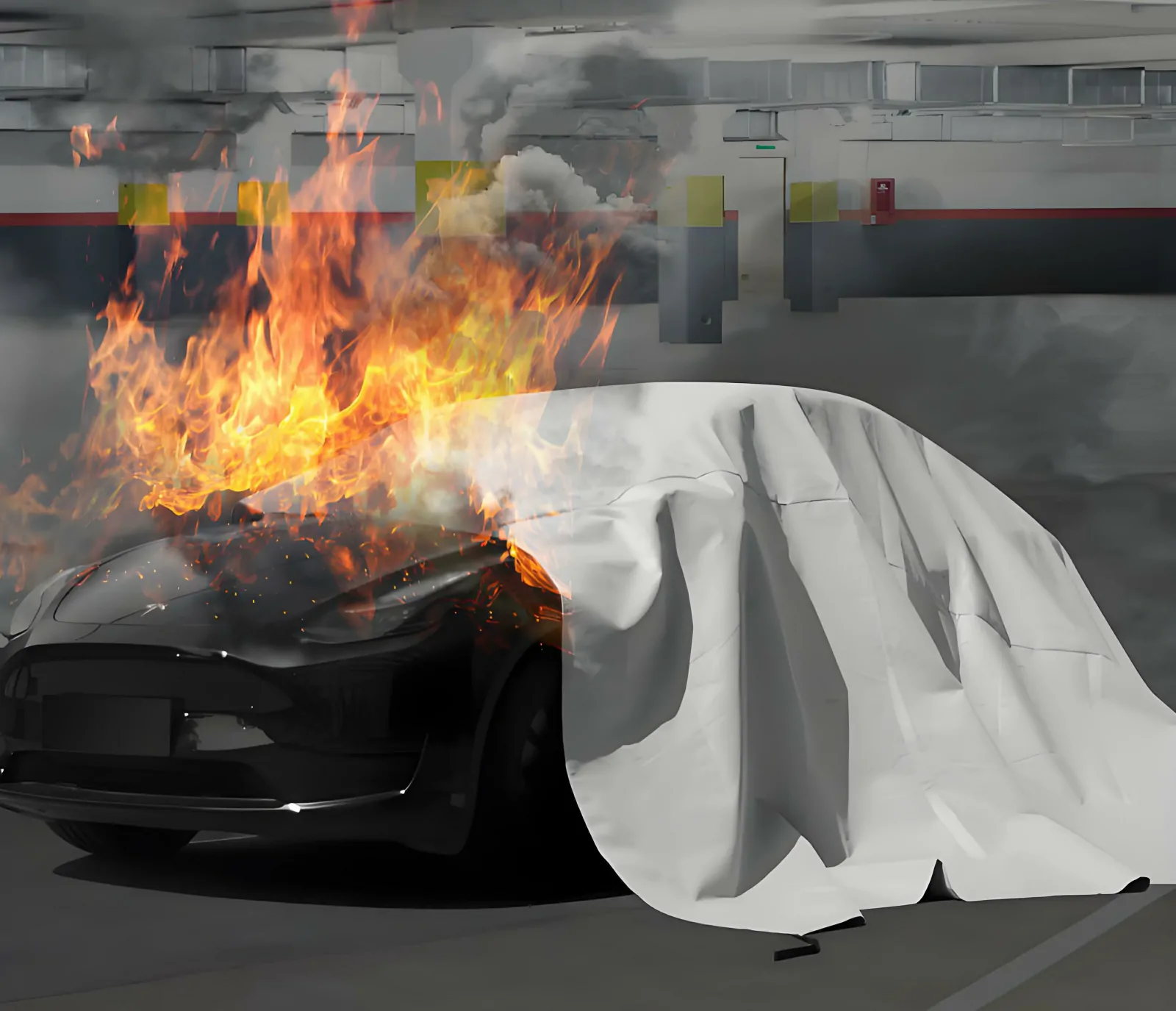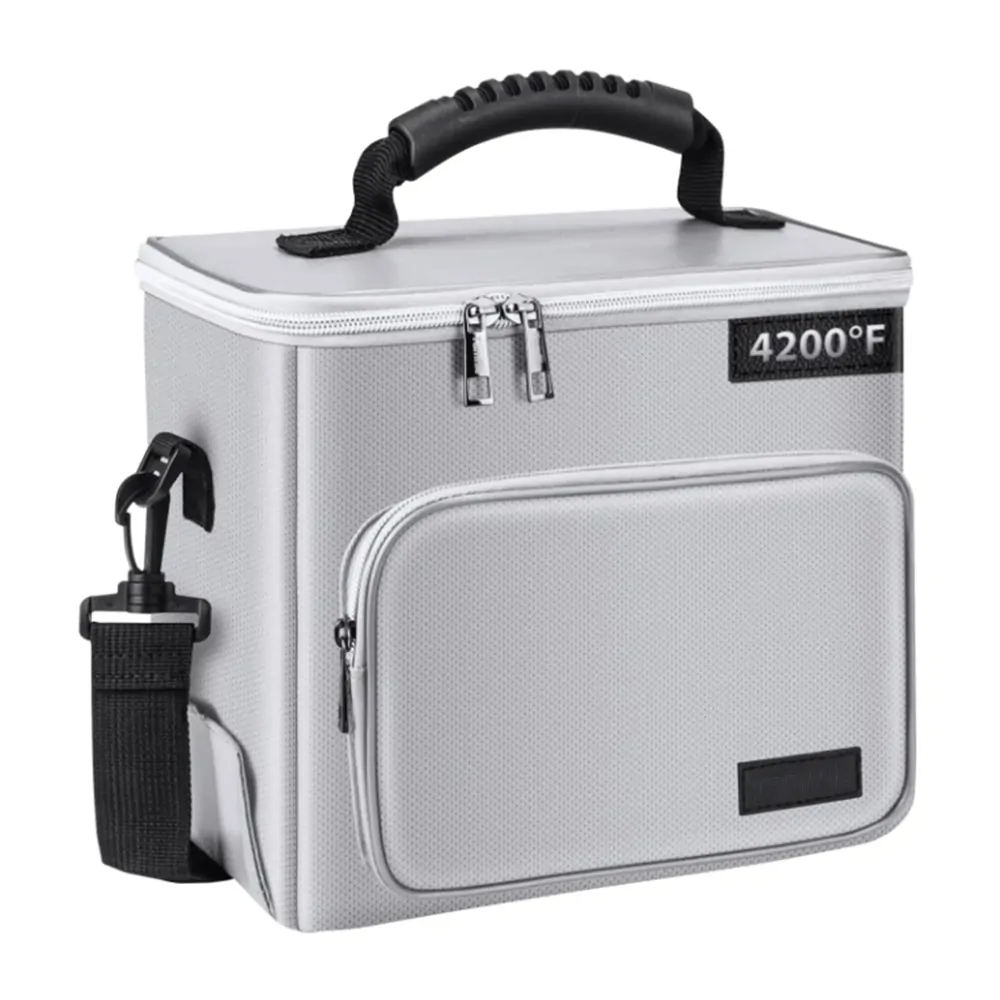Using fire extinguishers and fire blankets to suppress or control fires is common knowledge, but in fire safety, the question is never just “what to use”—it’s about “what specific type of fire suppression tool to use for a specific type of fire.” This distinction is critical, especially when dealing with lithium-ion battery fires.
If by “regular fire blanket” you mean an untreated, non-coated base fabric fire blanket—such as a fiberglass or high-silica fire blanket without additional fire-resistant coatings—then the answer is a resounding No Way. Trying to fight an EV battery fire with an uncoated fire blanket is like bringing a knife to a gunfight—you’re just giving the fire something new to consume.
So, the real question isn’t whether a regular fire blanket will work—it won’t. The question is: what should you actually use to suppress a lithium-ion battery fire?
Lithium Battery Fire

For small lithium battery fires, a fire extinguisher might create unnecessary mess, making a fire blanket a convenient alternative. Simply pull the handles, unfold the blanket over the burning flames, and quickly cover them, suffocating the fire by cutting off oxygen. For grease fires or small-scale fire incidents, this method is one of the most effective fire suppression solutions.
However, kitchen fires rarely exceed 600–800°C (1112–1472°F), and at these temperatures, fiberglass fire blankets can withstand direct exposure without issue—much like Captain America’s shield, they won’t burn through. Once the fuel is exhausted, the fire goes out. Dispose of the blanket, clean up the area, and life goes on.
Lithium battery fires, however, operate under an entirely different principle. The primary danger comes from thermal runaway, a chain reaction where the battery generates its own oxygen and heat, sustaining combustion even after external flames appear controlled. Once initiated, this process can cause temperatures to rapidly exceed 1000°C (1832°F) and peak at 1329°C (2424°F), as recorded in Safeprotex’s controlled fire testing. Heat release rates (HRR) have been observed to exceed 500 kW/m², significantly higher than common combustibles like wood or plastic. Additionally, debris and shrapnel from exploding battery cells can further spread flames, increasing containment challenges.
Beyond extreme heat, lithium-ion battery fires release hazardous gases, including hydrogen fluoride (HF), carbon monoxide (CO), and hydrogen cyanide (HCN). In laboratory tests, HF concentrations reached 200-500 ppm within minutes, a level considered immediately dangerous to life and health (IDLH) by OSHA standards. Additionally, violent flame ejections can project hot gases and battery cell fragments up to 3 meters (10 feet) away, increasing the risk of secondary ignition.
Why Regular Fire Blankets Fail

Many sources claim fire blankets can extinguish lithium battery fires, but this is a misconception. Modern fire protection strategies focus on containment, not direct suppression. Across the U.S., fire departments do not “put out” lithium battery fires but instead submerge them in large volumes of water (~500–800 gallons / 1890–3028 liters) to cool the cells and allow the chemical reaction to stabilize.
However, water is not always available, and fires involving lithium batteries rarely occur in ideal suppression environments. Thermal runaway is unpredictable, leaving little time for preparation. In such cases, the priority shifts to preventing flame spread and containing toxic gas emissions.
Contrary to common belief, lithium battery fires impose even greater demands on containment blankets than EV car fires. While EV car fires involve a burning electric vehicle, the blanket covers the entire car, often acting as an insulating barrier rather than making direct contact with the battery pack. In contrast, lithium battery unit fires expose the fire blanket directly to peak thermal runaway conditions, requiring enhanced high-temperature resistance, gas containment, and flame penetration protection.
- To meet these demands, a suitable fire containment blanket must:
- Withstand prolonged period exposure to temperatures exceeding 1300°C (2372°F)
- Provide high gas-sealing efficiency (≥90%) to limit toxic fume release
- Exhibit flame penetration resistance per ASTM E119 and ISO 2685
- Prevent molten metal penetration, withstanding heat flux of at least 200 kW/m²
- Be manufactured from high performance, fire resistant materials to ensure durability
Standard fiberglass blankets fail because they begin to degrade at ~900°C (1652°F), with coatings deteriorating well before that, leading to embrittlement and gas permeability. For effective containment, materials such as high performance high-silica fabric with ceramic coatings or multi-layered, high-purity vermiculite-coated fiberglass are required.
Choosing the Right Fire Blanket for Lithium Battery Fires

Selecting the right fire containment blanket is critical for lithium battery fire suppression. Standard fiberglass fire blankets (max temperature resistance: 550°C / 1022°F) are inadequate for lithium battery fires, as they break down into molten glass within seconds under extreme heat. Silica lithium ion fire blanket (softening point: 1700°C / 3092°F) can withstand higher temperatures but lack gas containment, allowing toxic fumes to escape, making them unsuitable for full lithium battery fire protection.
To effectively contain thermal runaway, lithium ion fire blanket must offers high-temperature resistance, gas containment, and flame penetration prevention. Certifications like NFPA 701, UL 94 V-0, FM 4950, and ISO 2685 provide industry validation for these materials, ensuring fire safety compliance and operational reliability.
If you need guidance on selecting the right fire blanket, check out our [Fire Blanket Procurement Guide] to ensure compliance and the best fire safety solution for your needs.
Fire Blankets for Lithium Battery Units

The choice of coating determines a lithium battery fire blanket’s effectiveness in heat resistance, gas containment, and durability. Silicone coatings provide flexibility and heat resistance, making lithium ion fire blanket ideal for smaller lithium-ion battery fires. Vermiculite coatings enhance molten metal resistance, suited for larger battery modules exposed to prolonged heat. Graphite coatings offer superior gas containment, reducing toxic emissions and ensuring long-duration protection in industrial lithium-ion storage.
Additionally, handling loops on high-performance lithium-ion battery fire blankets allow quick and secure deployment, enabling emergency responders to rapidly contain burning battery units and improve fire suppression efficiency.
| Fire Blanket Type | Temperature Resistance | Key Benefits | Relevant Certifications |
| Silicone-Coated High-Silica | 1100°C / 2012°F | Flexible, lightweight, ideal for small lithium battery packs | NFPA 701, UL 94 V-0, ASTM E84 |
| Vermiculite-Coated High-Silica | 1300°C / 2372°F | Molten metal resistance, prolonged fire exposure capability | ISO 2685, ASTM D6413 |
| Graphite-Coated High-Silica | >1300°C / 2372°F | Extreme heat shielding, superior gas containment | FM 4950, ASTM E119 |
Fire Blankets for EV Battery Fires
Electric vehicle (EV) fires require large-scale containment solutions to suppress flames, prevent re-ignition, and limit hazardous gas exposure. Unlike direct lithium battery fires, EV fires involve multiple combustible materials, and EV blanket primarily covers the entire vehicle rather than making direct contact with the battery core.
| Fire Blanket Type | Temperature Resistance | Key Benefits | Relevant Certifications |
| Silicone-Coated Fiberglass / High-Silica | 1100°C / 2012°F | General EV fire control, flexibility for deployment | NFPA 701, ASTM E84 |
| Vermiculite-Coated Fiberglass / High-Silica | 1300°C / 2372°F | Prevents molten metal penetration from burning EV batteries | ISO 2685, ASTM D6413 |
| Graphite-Coated Fiberglass / High-Silica | >1300°C / 2372°F | Maximum containment, high-temperature endurance | FM 4950, ASTM E119 |
Certification
lithium ion blanket must comply with international fire safety standards to ensure reliable containment and compliance with fire safety regulations. The following fire blanket certifications validate a fire blanket’s effectiveness, durability, and fire resistance properties:
- NFPA 701 – Ensures fire-retardant textiles meet U.S. flammability requirements.
- UL 94 V-0 – Confirms that materials self-extinguish in high-temperature environments.
- ASTM E84 – Measures flame spread and smoke development for gas containment.
- FM 4950 – Certifies industrial fire-resistant blankets for hot work and extreme heat containment.
- ISO 2685 – Ensures extreme heat and flame penetration resistance for aviation and aerospace applications.
- ASTM D6413 – Verifies flame resistance and material integrity under prolonged fire exposure.
- ASTM E119 – Tests structural fire resistance for prolonged thermal containment.
The Best Defense Is a Good Offense

Instead of scrambling to control a lithium-ion battery fire after ignition, why not prevent it from happening in the first place? Lithium battery safety bags provide proactive containment, reducing fire risks before they escalate.
Certified under NFPA 855 and UL 94 V-0, these fire-resistant enclosures use high-performance silica glass fabric with vermiculite or graphite coatings, capable of withstanding extremely high temperatures (up to 1200°C / 2192°F) and blocking over 90% of toxic gas emissions. Used in EV battery storage, aerospace applications, and high-energy battery transport, they help mitigate thermal runaway risks and improve fire safety compliance.
For NFPA-compliant fire safety planning, integrating lithium-ion battery fire blankets and containment bags into battery storage protocols ensures comprehensive risk management. Leading EV manufacturers and industrial safety teams rely on these advanced containment solutions to protect facilities, personnel, and high-value assets.
Fire safety isn’t just about reacting to fires—it’s about being prepared before they happen. Whether you need a lithium battery fire blanket for emergency response or a fire-resistant storage solution to prevent thermal runaway, choosing the right protection is critical.
At Safeprotex, we provide certified fire blankets and advanced fire safety solutions designed for lithium-ion battery risks. If you’re looking for reliable, high-performance fire protection, we’ve got you covered.
Need a lithium battery fire blanket or a complete fire safety solution? Contact Safeprotex today—we’re here to help.
